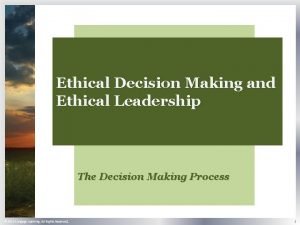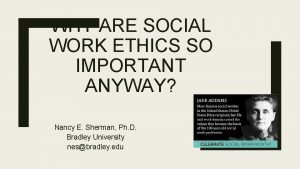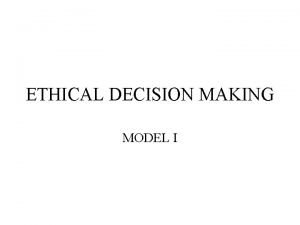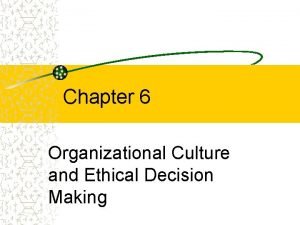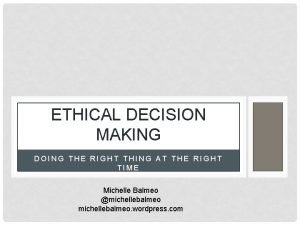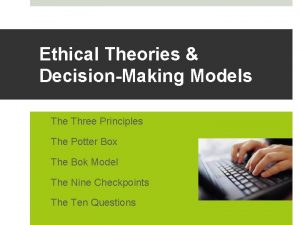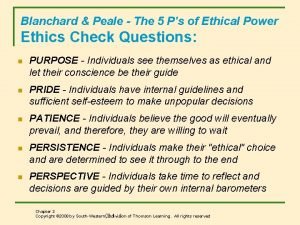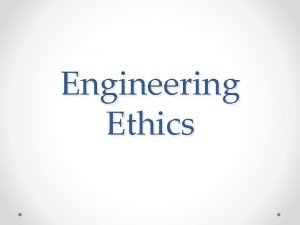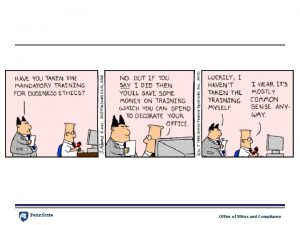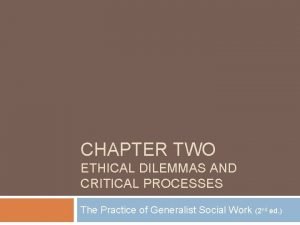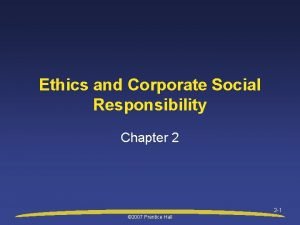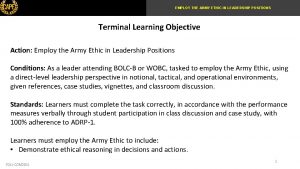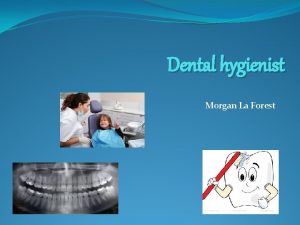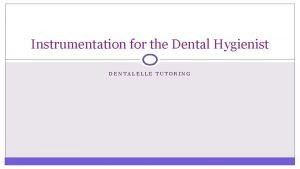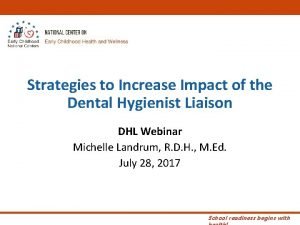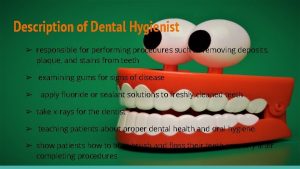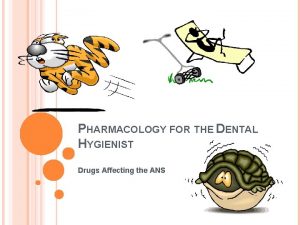Ethical Decision Making for the Dental Hygienist Chelsea




















- Slides: 20

Ethical Decision Making for the Dental Hygienist Chelsea Huntington, RDH, BS Student Teaching Internship- MSDH University of Bridgeport Fones School of Dental Hygiene The Code of Ethics and Ethical Analysis Beemsterboer CH 5 and 6

Outline of Todays Lesson � Define Ethics Professional Codes of Ethics In Healthcare. � Review Dental Hygiene Code of Ethics. Ethical Responsibility Ethical Dilemmas for the Dental Hygienist � Define Ethical Dilemma � Explain 6 Step Ethical Decision Making Model � Demonstrate Problem Solving and Ethical Decision Making Process

Ethics �General standards of right and wrong that guide behavior within society. They can be judged by determining the extent to which they promote good and minimize harm. �Ethics compel us to engage in health promotion/disease prevention activities.

Professional Codes in Healthcare � Guide for members to � Binds the members of � Contract the � maintain and uphold important standards of behavior and care. profession makes with society outlining the standards it will adhere to. the group together by expressing common goals and aspirations. An essential characteristic of a TRUE PROFESSION. (Beemsterboer CH 5)

How do we know if code of ethics are effective? � 1. Professional health care schools screen candidates for admission into their programs based not only on academic ability but good moral character and integrity. � 2. It is assumed each student until proven otherwise has traits to be a true professional. � 3. After entering professional practice it is the obligation of those professionals to regulate their profession. Beemsterboer Ch 5, pg 66.


The Dental Hygiene Code Has Seven Components �Preamble �Purpose �Key Concepts �Basic Beliefs �Fundamental Principles �Core Values �Standards of Professional Responsibility Beemsterboer Ch 5, pg 75, Appendix 5 -1.

Fundamental Principles & Core Values Should be made with the best interest of the patient in mind. Considering values and perspectives of others. Autonomy and Confidentiality Protection of the patient’s personal information. The right to informed consent, relevant information and respect. Justice and Fairness Consider the “Patient Bill of Rights”. Value fair distribution of high quality health care. Complementarity

Fundamental Principles & Core Values Place patients interest about you own Promoting “well being” and disease prevention activities. Nonmaleficence Be concerned for the patients welfare. Provide services that protects clients and minimizes harm. Veracity and Societal Trust Value self knowledge and be truthful in the evaluation of your own work Value patient trust and understand that our profession is based on our actions/ behavior. Beneficence

Fundamental Principles & Core Values Universality Provide highest standard of care. Judgment of right vs. wrong should be the same among others in the profession. Responsibility Accept our responsibility to make ethical choices. Accept our consequences of failure to make ethical decisions. Community Make bonds between individuals and society as a whole. Show concern for global environment.

Standards of Professional Responsibility To Ourselves as Individuals To Ourselves as Professionals To Colleagues, Employees and Employers To The Dental Hygiene Profession, The Community and Society To Family, Friends and Clients To Scientific Investigation/ Research

Being Ethical is a Responsibility �What happens if you can’t meet your responsibility? �What is a dilemma? It is an ethical problem. It is predicament, perplexity, doubt How can you move through predicament, perplexity, and doubt?

Ethical Dilemmas for the Dental Hygienist 1. 2. 3. 4. 5. 6. 7. 8. Substandard care Overtreatment Scope of Practice Fraud Confidentiality Impaired Professional Sexual Harassment Abuse Beemsterboer Ch 6, pg 90


Conditions That Effect Ethical Decisions �Economic �Social �Political �Legal

Levels of Ethical Awareness Moral Weakness Moral Uncertainty Moral Dilemma • When responsibilities conflict with personal decisions. • Questions as to whether a moral obligation exists and to what degree. • Obligations and or responsibilities are in conflict. Beemsterboer. CH 6 - pg, 85.

Learning Ethical Decision Making: The Ethical Decision Making Model �Some decisions are simple- right vs. wrong, whereas others may be ethical dilemmas. �Ethical decision making models suggest a mechanism for critical thinking and resolution of a problem. Darby Model (Seven Steps) Ethical Awareness separated Beemsterboer Model (Six Steps) Ethical awareness integrated Beemsterboer Ch 6, pg 86

Model Six Step � 1. Define the problem or � 4. Apply the ethical � 2. Collect information, � 5. Establish an ethical conflict, identify if this is an ethical issue/dilemma. including the values of all parties. � 3. Identify/ state the alterative options. principle to the options (look at code of ethics) position (justify and defend alternative). Make the decision. State your decision. � 6. Act or implement the ethical decision. Beemsterboer Ch 6, pg 88

Collect Information Implement the Options State the Options Identify the Problem Make the Decision Apply Ethical Principles to the Options

In Class Exercise “Problem Solving” Groups of 3 � Read Ethical Case Study # 4, (Pg 172) � Use six step model- Worksheet (Handout) � Use code of ethics – CH 5 � Solve dilemma (Make sure to justify using the six parts of the code) � Someone keep track by taking notes � Pass in notes at end of exercise with team members names on the worksheet.
 Keiser university dental hygienist
Keiser university dental hygienist Dental hygienist advancement opportunities
Dental hygienist advancement opportunities National dental hygienist week
National dental hygienist week Ethical decision making and ethical leadership
Ethical decision making and ethical leadership Kerridge's decision making model
Kerridge's decision making model Essential steps for ethical problem-solving
Essential steps for ethical problem-solving Introduction to ethical decision making
Introduction to ethical decision making Organizational culture and ethical decision making
Organizational culture and ethical decision making Potter's box for ethical decision making
Potter's box for ethical decision making Bok's model of ethical decision making
Bok's model of ethical decision making Ethical decision making metric
Ethical decision making metric Blanchard-peale
Blanchard-peale 7 steps model for ethical decision making
7 steps model for ethical decision making 7 step ethical decision making model
7 step ethical decision making model Ethical decision making
Ethical decision making Ethical decision making
Ethical decision making Dolgoff ethical principles screen
Dolgoff ethical principles screen No decision snap decision responsible decision
No decision snap decision responsible decision Slidetodoc.com
Slidetodoc.com Perbedaan ethical dilemma dan ethical lapse
Perbedaan ethical dilemma dan ethical lapse Ethical lenses army
Ethical lenses army



